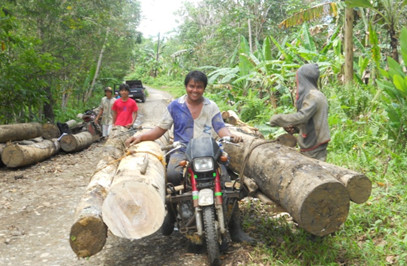![Log transport by river rafting. (Photo by Diomedes A. Racelis, University of the Philippines Los Baños-College of Forestry and Natural Resources [UPLB-CFNR]). Log transport by river rafting. (Photo by Diomedes A. Racelis, University of the Philippines Los Baños-College of Forestry and Natural Resources [UPLB-CFNR]).](/images/stories/2014/img022414_02a.jpg) The Caraga Region is fortunate to have some of the remaining tree stands in the country. However, as a major timber-producing region, it needs effective and sustainable management schemes to keep its forest productive.
The Caraga Region is fortunate to have some of the remaining tree stands in the country. However, as a major timber-producing region, it needs effective and sustainable management schemes to keep its forest productive.
This concern is addressed by PCAARRD’s “Action Program on the Establishment of Commercial Plantations and the Efficient Utilization of Wood Products in the Caraga Region.”
Harvesting is one of the crucial phases of lumber production. The selection and manner of harvesting should maximize the potential use of natural resources. Likewise, the regenerative capacity of the forest must not be hampered to ensure that the future generation’s use will not be compromised.
Under the action program is the project on providing viable harvesting technologies. This study targets to support commercial and small-scale tree farmers by providing sustainable harvesting technologies. To achieve this, field surveys and documentation of conventional and improved harvesting techniques are done. Cost-effective harvesting techniques are also identified for the benefit of small tree farmers.
 Among the recent undertakings of the project are the reconnaissance surveys at the Department of Environment and Natural Resources offices in the towns of Bayugan, San Francisco, Talacogon, and Nasipit in Agusan del Sur. Tree farmers and harvesting contractors were interviewed to assess the nature and extent of timber harvesting in their respective areas.
Among the recent undertakings of the project are the reconnaissance surveys at the Department of Environment and Natural Resources offices in the towns of Bayugan, San Francisco, Talacogon, and Nasipit in Agusan del Sur. Tree farmers and harvesting contractors were interviewed to assess the nature and extent of timber harvesting in their respective areas.
To gather data on felling and bucking, a time and motion study was started. The researchers documented the harvesting activities of tree farmers and hauling contractors, such as felling, bucking, on-site log conversion, manual hauling, carabao skidding, “habal-habal” hauling, modified skyline, and river rafting.
Information on productivity rates, production cost, and conversion ratio/cost were collected for the economic aspect.
Meanwhile, the environmental impacts of the harvesting methods were also noted.
Lastly, through the project, 52 tree farmers comprising six Community Environment and Natural Resources Offices’ jurisdictions participated in the training needs assessment for the drafting of information, education and communication materials on sustainable forest harvesting of smallhold tree farmers.
